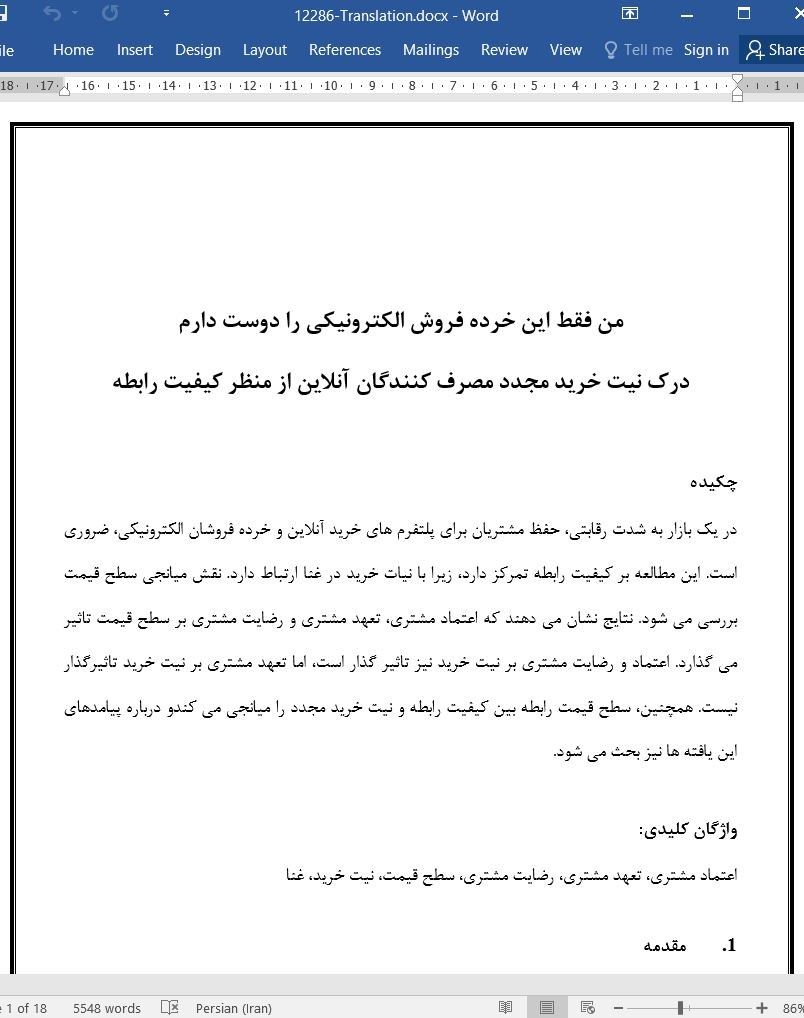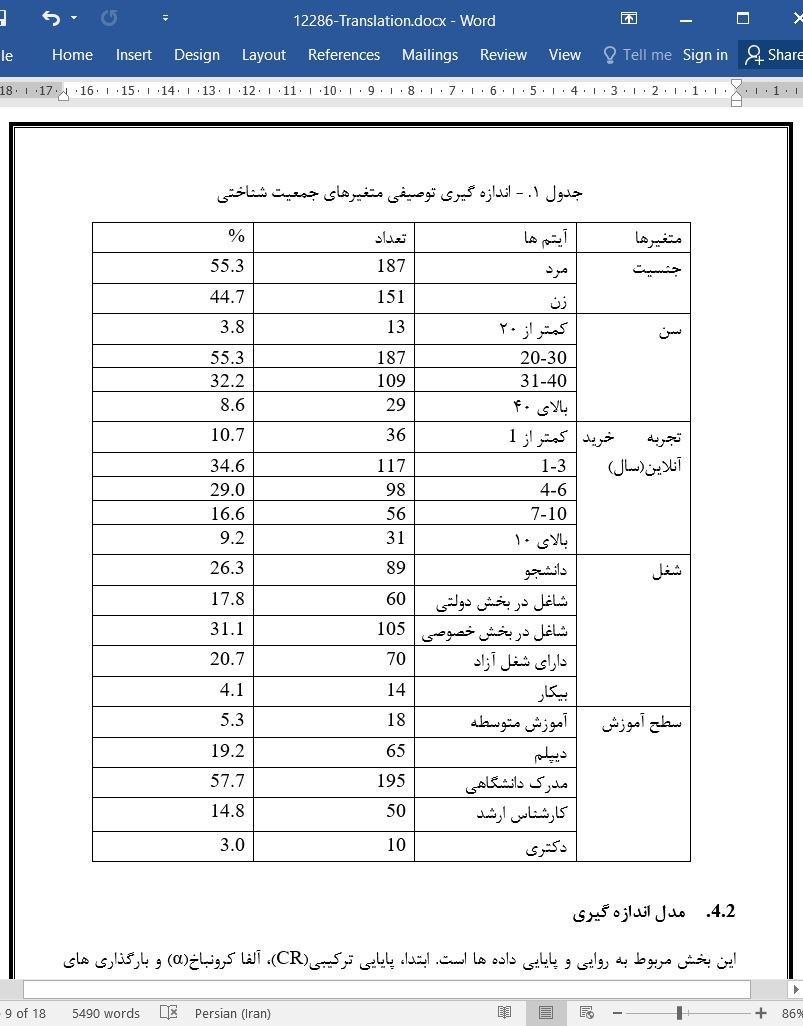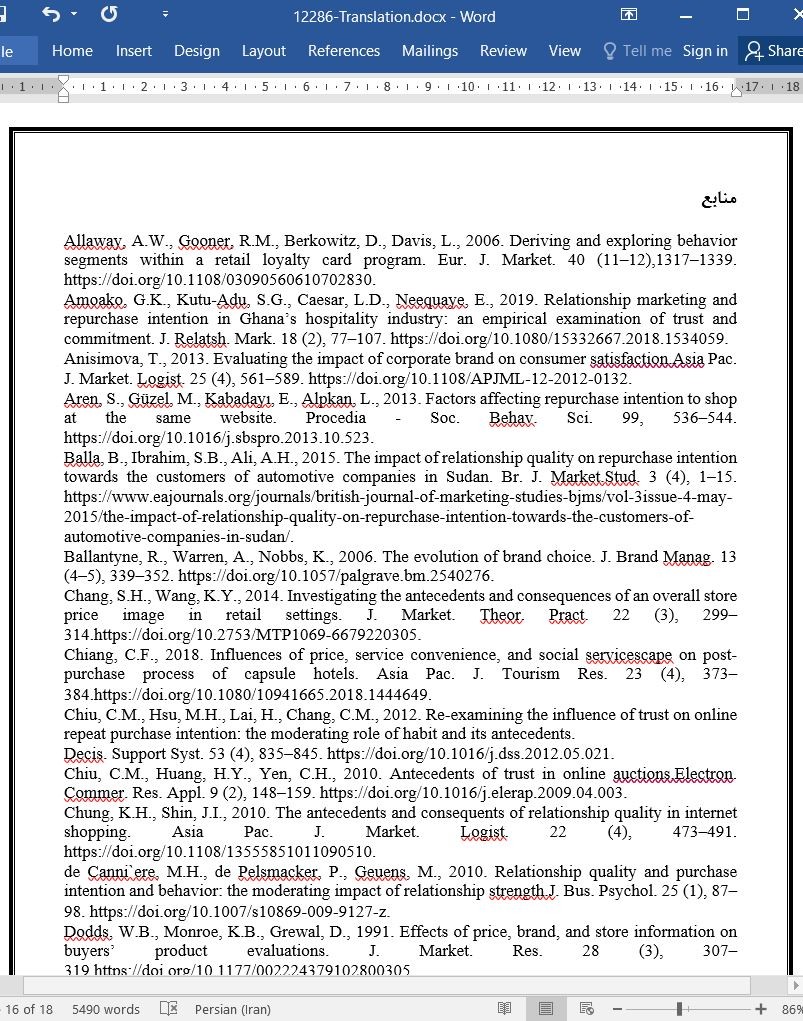
درک نیت خرید مجدد مصرف کنندگان آنلاین از منظر کیفیت رابطه
چکیده
در یک بازار به شدت رقابتی، حفظ مشتریان برای پلتفرم های خرید آنلاین و خرده فروشان الکترونیکی، ضروری است. این مطالعه بر کیفیت رابطه تمرکز دارد، زیرا با نیات خرید در غنا ارتباط دارد. نقش میانجی سطح قیمت بررسی می شود. نتایج نشان می دهند که اعتماد مشتری، تعهد مشتری و رضایت مشتری بر سطح قیمت تاثیر می گذارد. اعتماد و رضایت مشتری بر نیت خرید نیز تاثیر گذار است، اما تعهد مشتری بر نیت خرید تاثیرگذار نیست. همچنین، سطح قیمت رابطه بین کیفیت رابطه و نیت خرید مجدد را میانجی می کندو درباره پیامدهای این یافته ها نیز بحث می شود.
1. مقدمه
رشد تکنولوژیکی و نوآوری های کنونی، شرکت های زیادی را به صحنه آورده است. به طور مثال، زمانی که برنامه برگزیده دولت غنا به نام هر منطقه، یک کارخانه(1d1f) تکمیل شد، انتظار می رفت تعداد شرکت های کشور را حداقل تا دویست و هفتاد افزایش یابد. تاثیر تعداد شرکت های افزایش یافته (شرکت های آنلاین و آفلاین)، افزایش رقابت در بازار بود، در نتیجه اهمیت حفظ مشتری نیز افزایش یافت.
6. نتیجه گیری
این مطالعه به بررسی این موضوع می پردازد که چگونه مولفه های کیفیت رابطه بر نیت خرید مجدد مصرف کننده آنلاین در کشور غنا تاثیر میگذارد. بدین منظور یک چارچوب مفهومی تدوین شد و فرضیه ها ایجاد شدند. یافتههای تجربی دستاوردهایی ارائه داد. با این وجود، تحقیق دارای محدودیتهایی نیز میباشد. حوزه تحقیق، کشور غنا است و بدین ترتیب یافته ها ممکن است در سایر ناحیه های جغرافیایی کاربرد نداشته باشند. همچنین، در تحقیق تنها نیت خرید مجدد مصرف کنندگان آنلاین ارزیابی شد. تحقیق بیشتر باید به ارزیابی رفتار خرید مجدد واقعی مصرفکنندگان بپردازد تا مدل مفهومی ما را آزمون کند. در آخر، متغیرهای تحقیق در یک زمان ارزیابی شدند. به تحقیقات آتی پیشنهاد میکنیم از تکنیک طولی استفاده کنند تا تایید کنند که آیا یافته ها صحت دارد و مصرف کنندگان به خرید مجدد از همان خرده فروش الکترونیکی یا پلتفرم تجارت الکترونیک، ادامه خواهند داد یا خیر.
Abstract
In an increasingly competitive market, retaining customers is essential for both e-retailers and online shopping platforms. This study focuses on relationship quality as it pertains to repurchase intentions in Ghana. The mediating role of price level is addressed. The results show that customer trust, customer commitment, and customer satisfaction affect price level. Customer trust and satisfaction affect repurchase intention, but customer commitment does not affect repurchase intention. Also, price level mediates the relationship between relationship quality and repurchase intention. Implications of these findings are discussed.
1. Introduction
The recent technological growth and innovations have made more companies come into the scene. For example, the government of Ghana’s flagship program dubbed the One-District-One-Factory (1d1f), when completed, is expected to increase the country’s number by at least two hundred and seventy (270). The effect of the risen number of companies (both online and offline companies) is that competition in the market will be high, so as customer retention.
6. Conclusion
This study investigates how relationship quality constructs influence online consumer intention to repurchase in the Ghanaian context. To achieve this, a conceptual framework was developed, and hypotheses were raised. The empirical findings provided some contributions. Despite this, the research has some limitations. The study area was Ghana, and as such, the findings may not apply to other geographical regions. Also, the study measured only the online consumers repurchase intention. Future research should measure the consumers’ actual repurchase behavior to test our conceptual model. Lastly, the research variables were measured at one time. We suggest future studies should take a longitudinal technique into consideration to confirm if the findings would remain the same as consumers continue to repurchase from the same e-retailer or e-commerce platform.
چکیده
1. مقدمه
2. مروری بر ادبیات پیشین
2.1. کیفیت رابطه
2.1.1. اعتماد مشتری
2.1.2. تعهد مشری
2.1.3. رضایت مشتری
2.2. سطح خرید
2.2.1. نقش میانجی سطح قیمت
2.3. نیت خرید مجدد مشتری
2.4. چارچوب مفهومی
3. روش های تحقیق
3.1. آیتم های اندازه گیری
3.2. جمع آوری داده
4. تحلیل داده ها و نتایج
4.1. اطلاعات جمعیت شناختی پاسخ دهندگان
4.2. مدل اندازه گیری
4.3. مدل ساختاری
5. بحث و دستاوردها
5.1. بحث
5.2. دستاوردهای تحقیقاتی
5.3. دستاوردهای عملی
6. نتیجه گیری
منابع
Abstract
1. Introduction
2. Literature review
2.1. Relationship quality
2.1.1. Customer trust
2.1.2. Customer commitment
2.1.3. Customer satisfaction
2.2. Price level
2.2.1. Mediating role of price level
2.3. Customer repurchase intention
2.4. Conceptual framework
3. Research methods
3.1. Measurement items
3.2. Data collection
4. Data analysis and results
4.1. Respondents demographic information
4.2. Measurement model
4.3. Structural model
5. Discussion and implications
5.1. Discussion
5.2. Implications for research
5.3. Implications for practice
6. Conclusion
Funding
Declaration of competing interest
References
- اصل مقاله انگلیسی با فرمت ورد (word) با قابلیت ویرایش
- ترجمه فارسی مقاله با فرمت ورد (word) با قابلیت ویرایش، بدون آرم سایت ای ترجمه
- ترجمه فارسی مقاله با فرمت pdf، بدون آرم سایت ای ترجمه



